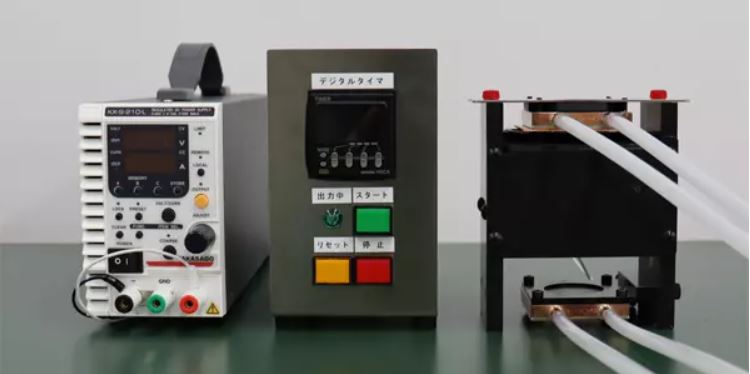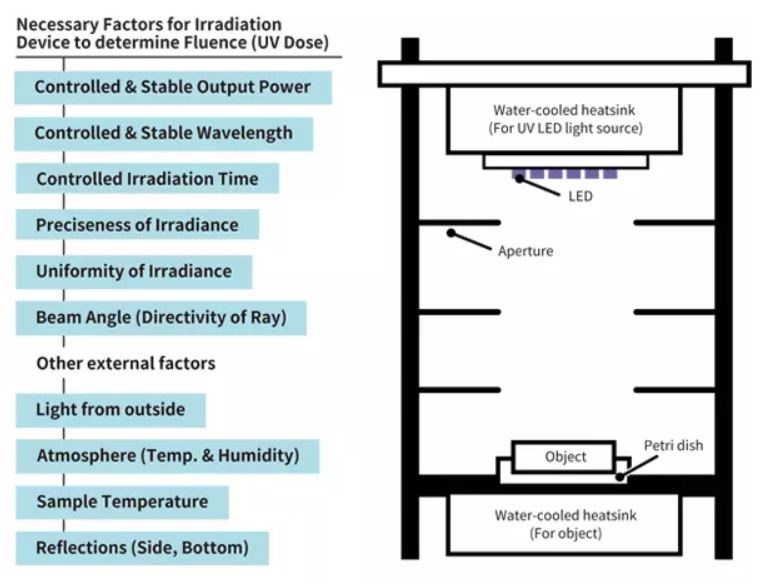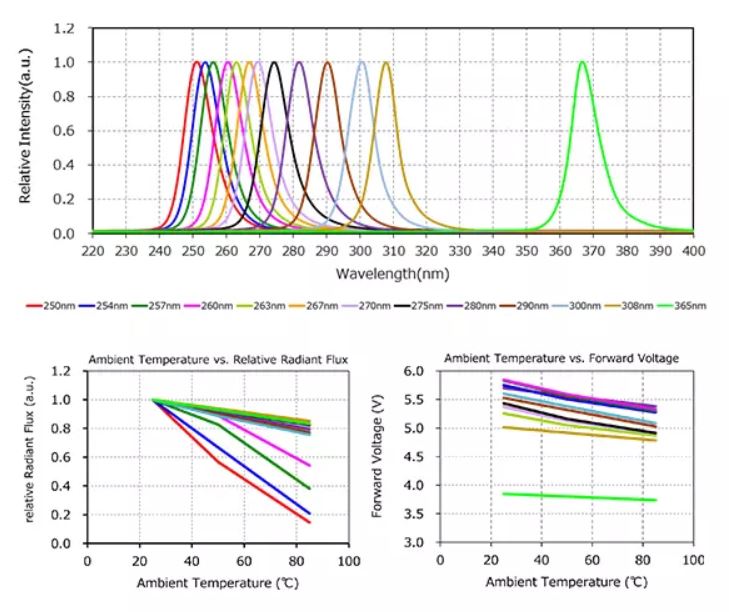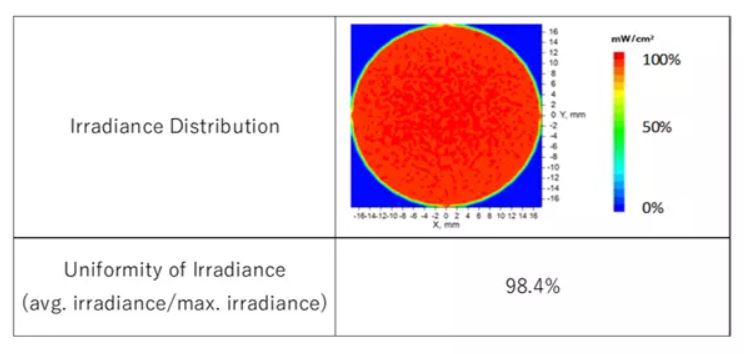Toward Standardization of Inactivation Evaluation
Highlights:
・Nichia developed a UV irradiant device to evaluate UV sensitivity for inactivation evaluation of microorganisms.
・The LED characteristics and design of the device meet the necessary conditions to make evaluations reproducible and accurate.
・UV LED peak wavelengths can be selected from 250nm to 365nm.
・This enables integrated evaluation of UV sensitivity, and assists in the commercialization of infection control devices.
Overview:
Tokushima, Japan – 30 May 2023: Nichia, the world's largest LED manufacturer and inventor of high-brightness blue and white LEDs, announces the development of an LED irradiation device used to evaluate UV sensitivity, including inactivation of microorganisms. This device is designed to enable highly accurate and repeatable evaluation of UV sensitivity, such as inactivation of microorganisms by UV light, taking into consideration the electrical and temperature characteristics of the LEDs, irradiance on the irradiated surface, irradiance distribution, irradiation time, beam angle, reflection from surrounding materials, sample temperature, etc. The device can be set to thirteen different wavelengths of UV LED from 250nm to 365nm.
The device was used by the Department of microbial control at the Tokushima University Graduate School of Biomedical Sciences to evaluate UV sensitivity of microorganisms. The results are currently going to be presented at the following academic conferences, with more to come.
June 15th-19th, 2023 ASM microbe 2023 (Houston, Texas, USA)
July 9th-13th, 2023 FEMS2023 (Hamburg, Germany)
August 29th -30th, 2023 The Society for Antibacterial and Antifungal Agents, 50th Annual Conference (Osaka, Japan)

Picture 1. Developed LED irradiation device (left: power source unit, center: timer, right: irradiation device)
Background:
Inactivation of microorganisms using UV light has been actively studied with mercury lamps, tunable wavelength lasers, and light emitting diodes (LED). In recent years, ultraviolet LEDs (UV LEDs) have been gaining attention as a solution for infection control equipment, due to the development of various wavelengths and the small form factor providing design flexibility.
However, irradiance conditions vary from study to study because no evaluation system or method suitable for UV LEDs regarding inactivation has been established.
It causes some confusion not being able to integrate effective evaluation of inactivation of microorganisms, therefore a standardized irradiation device and evaluation method are required.
Therefore, Nichia developed a UV LED irradiation device based strictly on irradiation conditions. In addition, the system enables the selection and evaluation of LEDs with multiple peak wavelengths ranging from 250nm to 365nm so that UV LEDs with various wavelengths can be compared.
Research Details:
UV sensitivity evaluation mainly evaluates how the object changes in response to fluence (UV Dose), which is the product of irradiance and irradiation time, so it is necessary to accurately determine the irradiance of the target surface and irradiation time.
This is why the irradiance of the target surface must be stable, the irradiance distribution must be uniform, and the irradiation time must be accurately controlled.
To develop the LED irradiance device, it is suggested that various factors, outlined in Figure 1, could cause uncertainty in the evaluation results.
For example, the output of a UV LED is affected by the junction temperature (temperature of the LED chip) and that temperature varies in different wavelengths. The irradiance device Nichia developed has a water-cooled heatsink around the UV LED so that increases in junction temperature is avoided.
Moreover, this study separately measured the LED characteristics of each wavelength since the value of the electrical and temperature characteristics depends on the peak wavelength of the UV LED. Considering that, the device is designed to evaluate UV sensitivity with high reliability in a wide wavelength range from 250nm to 365nm as shown in Figure 2.
Also, experimental conditions were set up with and without the requirements such as uniformity, beam angle, and reflection from surroundings and rear materials. Then each was compared to confirm conditions for a highly accurate UV sensitivity evaluation.
As a result, the device has a structure with a more uniform irradiance distribution to the object and is free from the effects of reflection and stray light inside the device. As shown in Figure 3, the irradiance distribution to the target object is approximately 98% uniform over a target area of 35mm in diameter.
In this way, the newly developed LED irradiation device is designed to consider all factors such as the electrical temperature characteristics of the LEDs, irradiance on the irradiated surface, irradiance distribution, irradiation time, beam angle, reflections from surrounding materials, and temperature of the sample.

Figure 1. Requirements for the irradiation device and illustrative diagram of the developed LED irradiation device

Figure 2. Selectable emission spectrum of UV LEDs and temperature characteristics of each wavelength

Figure 3. Irradiance Distribution
Future Plans:
Nichia and Tokushima University will administer tests by using the developed device in a joint research course named “Microbial Control Research” by Professor Akira Takahashi.
Nichia hopes that the results of this research help to commercialize infection control equipment by advancing the selection of LEDs, device design, and irradiation methods suitable for each target and application with respect to various microorganisms in human living spaces.
Moreover, the device makes it possible to not only inactivate microorganisms but evaluate the impact of UV light on materials and living organisms with different wavelengths. It will be useful in examining the use of UV light in society in a variety of fields.
Nichia will continue to optimize the design of the device considering objects in various fields and hopes that UV LEDs will solve various social challenges.
Terms:
Ultraviolet: Electromagnetic waves with wavelengths shorter than visible light, generally 10-400nm.
UV inactivation: Irradiating with UV to prevent growth of microbes and pathogenic microorganisms.
UV sensitivity evaluation: Evaluation of the effects of UV radiation on materials and living organisms.
Irradiance: Radiant flux per unit area.
Fluence: The product of irradiance and irradiation time (Units J/m2). Expressed also in terms of UV dose.
Uniformity of irradiance: The value of surface irregularity. Here it means the ratio of average to maximum irradiance.
TrendForce 2023 Deep UV LED Market Trend and Product Analysis
Release: 31 March, 30 September 2023
Language: Traditional Chinese / English
Format: PDF / EXCEL
Page: 50-60 / Semi-Annual
If you would like to know more details , please contact:





 CN
TW
EN
CN
TW
EN





